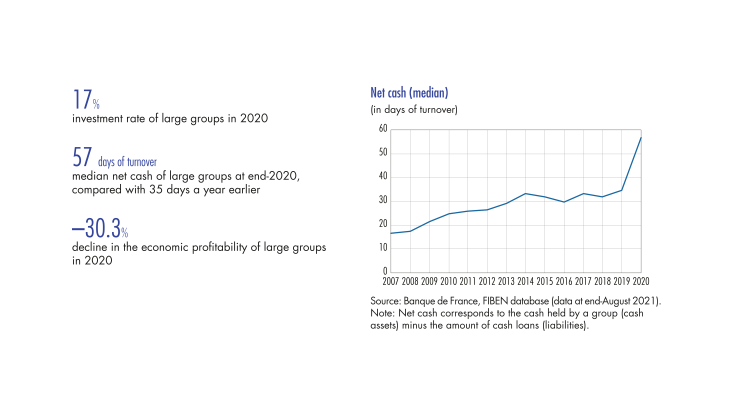This article analyses the economic and financial situation of large private non-financial groups in France in 2020, by drawing on the consolidated accounts of the Banque de France’s FIBEN database (Fichier bancaire des entreprises) (see Appendix 1). The scope of the study covers a total of 238 large groups.
1 Activity and results show a clear decline
The decline in the activity of large French groups was marked, but the change in value added was identical to that of the French economy as a whole
In 2020, the value added (VA) of large groups posted an average annual decrease of 5.8%, while French GDP dropped by 5.5% at current prices (and by 7.9% at constant prices, see Chart 1a). The activity of large French groups thus declined at the same rate as the French economy as a whole.
Turnover figures show a more pronounced decline in activity, with an average decrease of 10.0% in 2020 (see Chart 1b). More than half of the large groups experienced a decline in activity greater than that of GDP.
The fall was particularly pronounced for the large French industrial groups (in particular in the aeronautics, automobile and energy sectors) and for the accommodation and food services sector, which was particularly impacted by the consequences of the health measures (see Appendix 2 for figures by sector of activity). In 2020, the industrial sector alone accounted for over half of large French groups’ turnover (56%).
In 2020, the share of large groups’ turnover generated abroad (see Chart 2) dropped very slightly but remained at a historically high level. The global business shock differed across countries, which benefited the large groups operating in several geographical areas.
EBIT and recurring net income deteriorated due to higher personnel expenses and depreciation
In 2020, the value added of the large French groups held up better than their turnover, as they clearly succeeded in controlling their supplies (see Chart 3a). The strength of large groups’ value added is not entirely reflected in the evolution of EBITDA which, expressed as a percentage of turnover, remained relatively stable in 2019.
The two charts 3a and 3b compare the most important intermediate operating balances and their main components, relative to the level of turnover, in order to analyse what has weighed most on the net results.
[to read more, please download the article]
